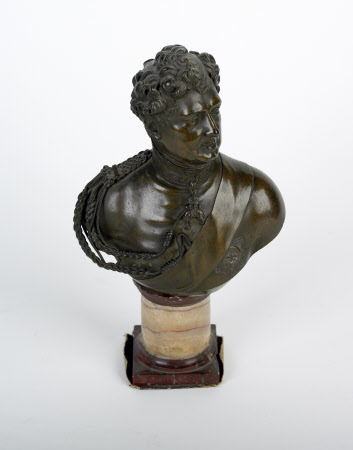Portrait bust of King George IV (1762-1830)
after Sir Francis Legatt Chantrey RA (Norton, nr. Sheffield 1781 – London 1841)
Category
Art / Sculpture
Date
c. 1820 - 1830
Materials
Bronze, Marble
Measurements
292 mm (Height); 165 mm (Length)
Place of origin
London
Order this imageCollection
The Argory, County Armagh
NT 565217
Summary
Sculpture, bronze; portrait of King George IV (1762-1830); British, after Sir Francis Leggatt Chantrey (1781-1841); c. 1820-1830. A miniature bronze bust depicting King George IV in uniform, after the marble portrait by Sir Francis Chantrey. Chantrey was commissioned in 1821 to make marble busts of the new king King George IV, who had succeeded to the throne on the death of his father George III in 1820. Small reductions in bronze and other materials were quickly published, possibly by Chantrey himself, but also by the royal goldsmiths Rundell, Bridge and Rundell, to cash in on demand for images of the new monarch.
Full description
A small bronze portrait bust of King George IV (1762-1830) as Prince Regent, wearing the uniform of a Field Marshal, with the badge of the Order of the Golden Fleece hanging from his collar, the Star of the Order of the Garter on his breast and a sash running across his chest from his left shoulder. The king is depicted looking to his left and slightly upwards. Mounted on a circular white marble column. The small bronze bust is based on the highly successful portrait of King George IV commissioned from Francis Chantrey in 1821. The first commissions were for two marble busts, one for the Duke of Devonshire, still at Chatsworth (Potts 1980, no. 2), the other for the Royal Collection, but no longer in the collection (Yarrington 1991-92, fol. 141b.). A version was exhibited at the Royal Academy in 1822 (no. 988), whilst the plaster model is in the Ashmolean Museum (Sullivan 2014, pp. 17-19, fig. 20). Further examples were commissioned, including one dated 1826 in the Royal Collection (RCIN 2136; Heard and Jones 2019, p. 46, fig. 3.1). Numerous other replicas were commissioned from Chantrey and his workshop, more than for any other bust by him, whilst a further sign of the success of the image was its use to provide the profile portrait of the king for the new coinage, designed by William Wyon in 1826. The demand for images of the new monarch was met in part by small bronzes of the type now at the Argory, many examples of which survive. Most of these, like the Argory bust, show George not draped in a Roman-style toga as he is in the marble busts, but in modern military dress, thus more evidently a contemporary portrait. It has been suggested, in the context of a wax version in the Victoria & Albert Museum (Inv. A.84-1936), that these busts were first made from around 1814, the year in which the Prince Regent was made a member of the Order of the Golden Fleece by the Austrian and the Spanish monarchs, and during which a preliminary meeting to the Congress of Vienna was held in Britain, with gatherings taking place at Petworth among other locations (see NT 486228). However, the king seems a little older in this portrait than in others made around 1815, whilst the likeness is so evidently the same as that of Chantrey’s marble, that it seems improbable that the bronzes can predate the marbles. Since Chantrey ran his own foundry within his workshops, it would seem entirely conceivable that the model for the miniature bust was made in his workshop and that some casts were produced in this foundry. A wax version of the portrait in the Victoria & Albert Museum (Inv. A.84-1936) may have been a model, made as part of this process. Some of the small busts were however certainly furnished by the Royal goldsmiths Rundell, Bridge and Rundell (Hartop 2005, p. 90, fig. 79 for a signed example), whilst Rundells also made some very elaborate versions, such as the gilt-bronze bust on a socle wit the royal arms, in the Royal Pavilion Brighton (on loan from the Regency Society of Brighton and Hove), or the one on an even more elaborate base mounted with enamel, gold, diamonds, emeralds, and rubies, made in 1830 and now in the Boston Museum of Fine Arts (Inv. 2005.93.1-2). Other manufacturers also produced these busts, more or less faithfully copied from Chantrey’s model, for example the goldsmith and jeweller Thomas Hamlet (1793-1849), who marketed a pair of small busts of George IV, the king here shown draped, and his brother Frederick, Duke of York (1763-1827), currently on the art market (with Finch and Co.). These are inscribed on the back ‘Published by T.Hamlet 1 Jan 1823’. Yet another variation is a small bronze bust, at Belton House (NT 435412), depicting the king in rather crude armour, over which is a swag of drapery. Other unsigned examples of the same model as the Aergory version, with George IV in his field marshal’s uniform, have appeared at auction (e.g. Christie’s London, 20 September 2001, lot 77 and 23 January 2002, lot 227). Jeremy Warren October 2022
Provenance
By descent; Walter McGeough Bond (1908-86), by whom given to the National Trust in 1979.
Makers and roles
after Sir Francis Legatt Chantrey RA (Norton, nr. Sheffield 1781 – London 1841), sculptor
References
Potts 1980: Alex Potts, Sir Francis Chantrey 1781-1841. Sculptor of the Great, exh. cat., National Portrait Gallery, London 1980 Yarrington, Lieberman, Potts and Barker 1991-1992: Alison Yarrington, Ilene D. Lieberman, Alex Potts and Malcolm Barker, ‘An Edition of the Ledger of Sir Francis Chantrey R.A., at the Royal Academy, 1809-1841, The Volume of the Walpole Society, 1991-1992 Hartop 2005: Christopher Hartop, Royal Goldsmiths: The Art of Rundell and Bridge 1797-1843, (John Adamson, Cambridge, 2005) Sullivan 2014: M.G. Sullivan, Sir Frances Chantrey and the Ashmolean Museum, Oxford 2014 Heard and Jones 2019: Kate Heard and Kathryn Jones, eds., George IV. Art and Spectacle, London 2019
